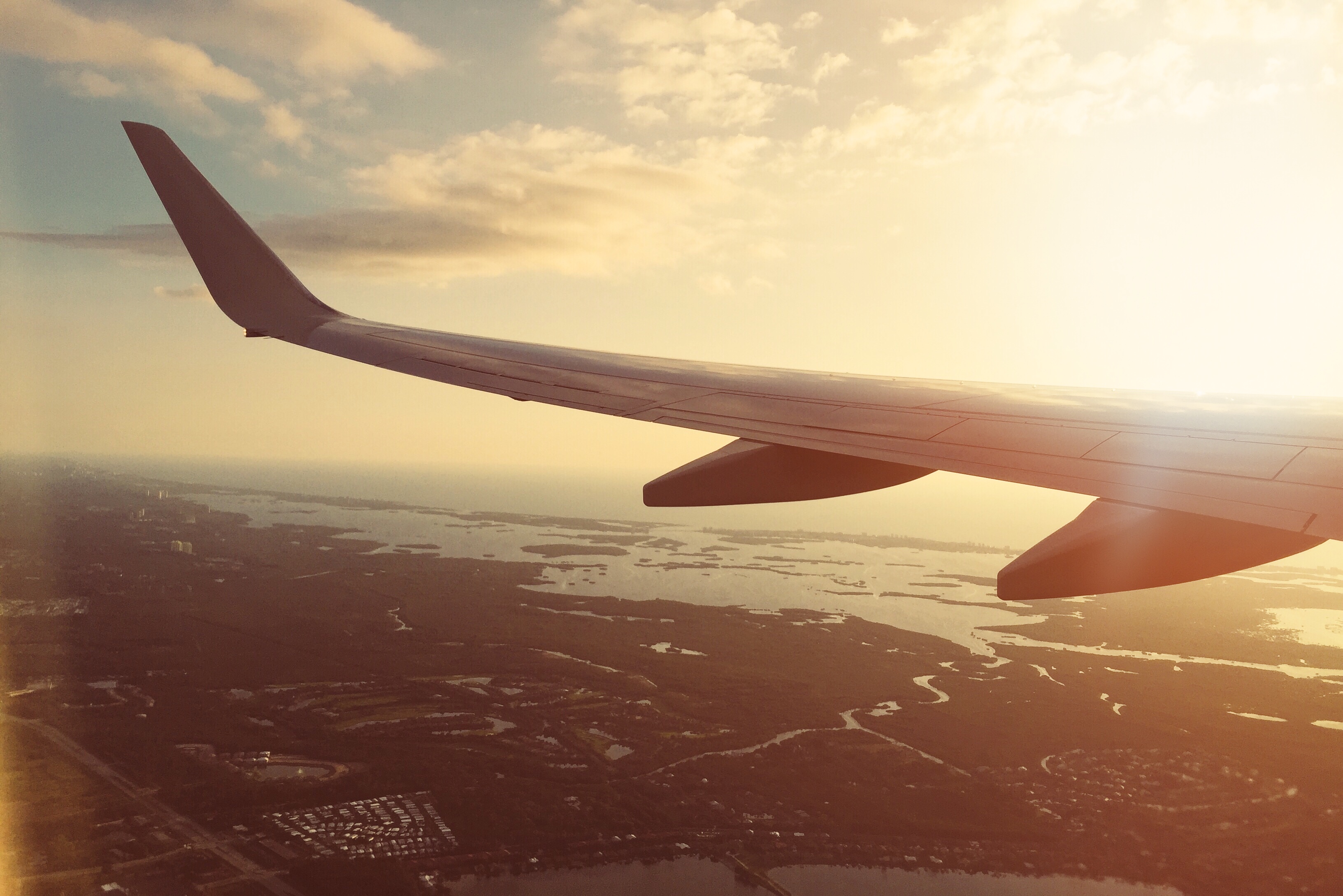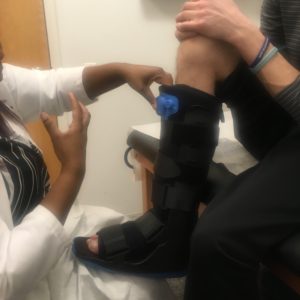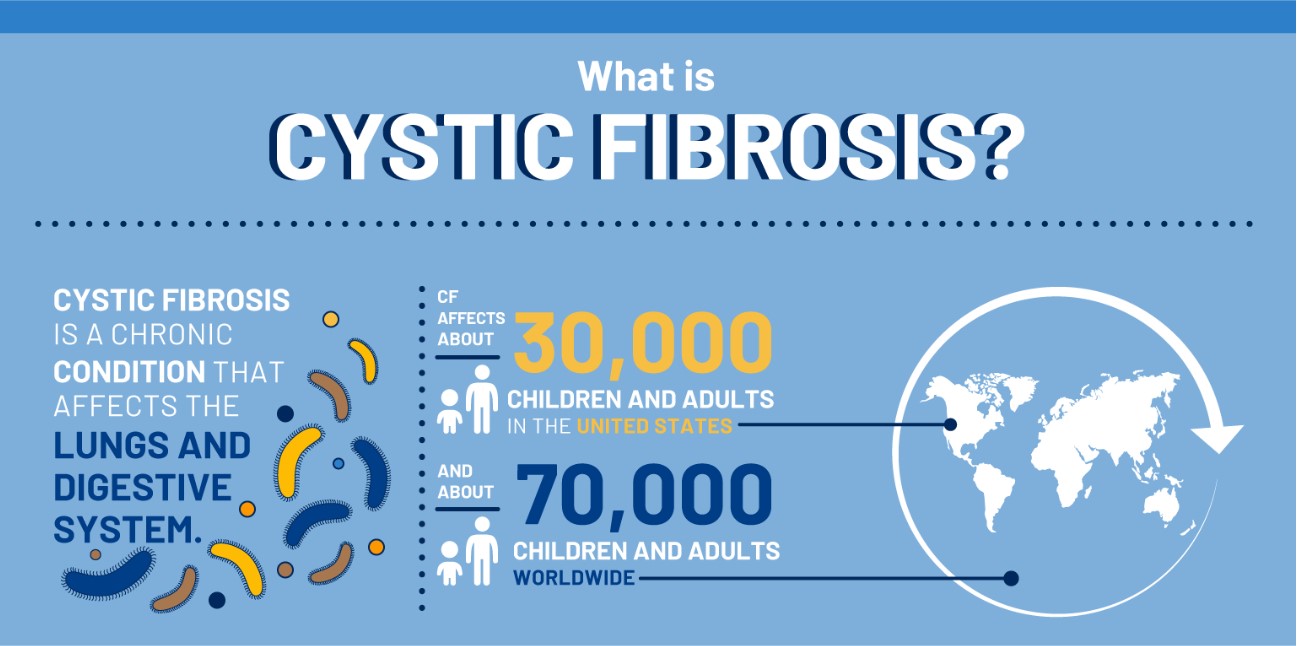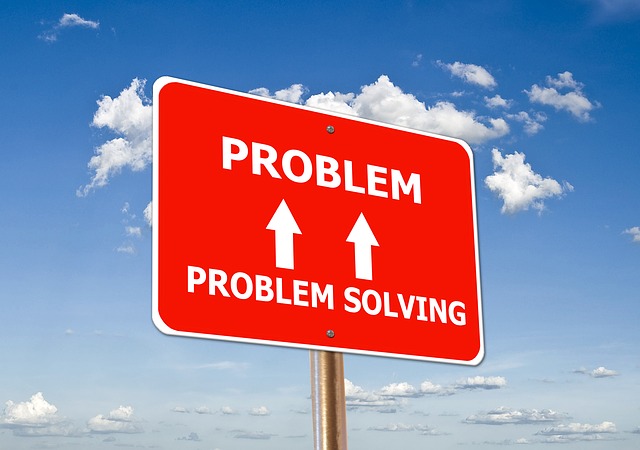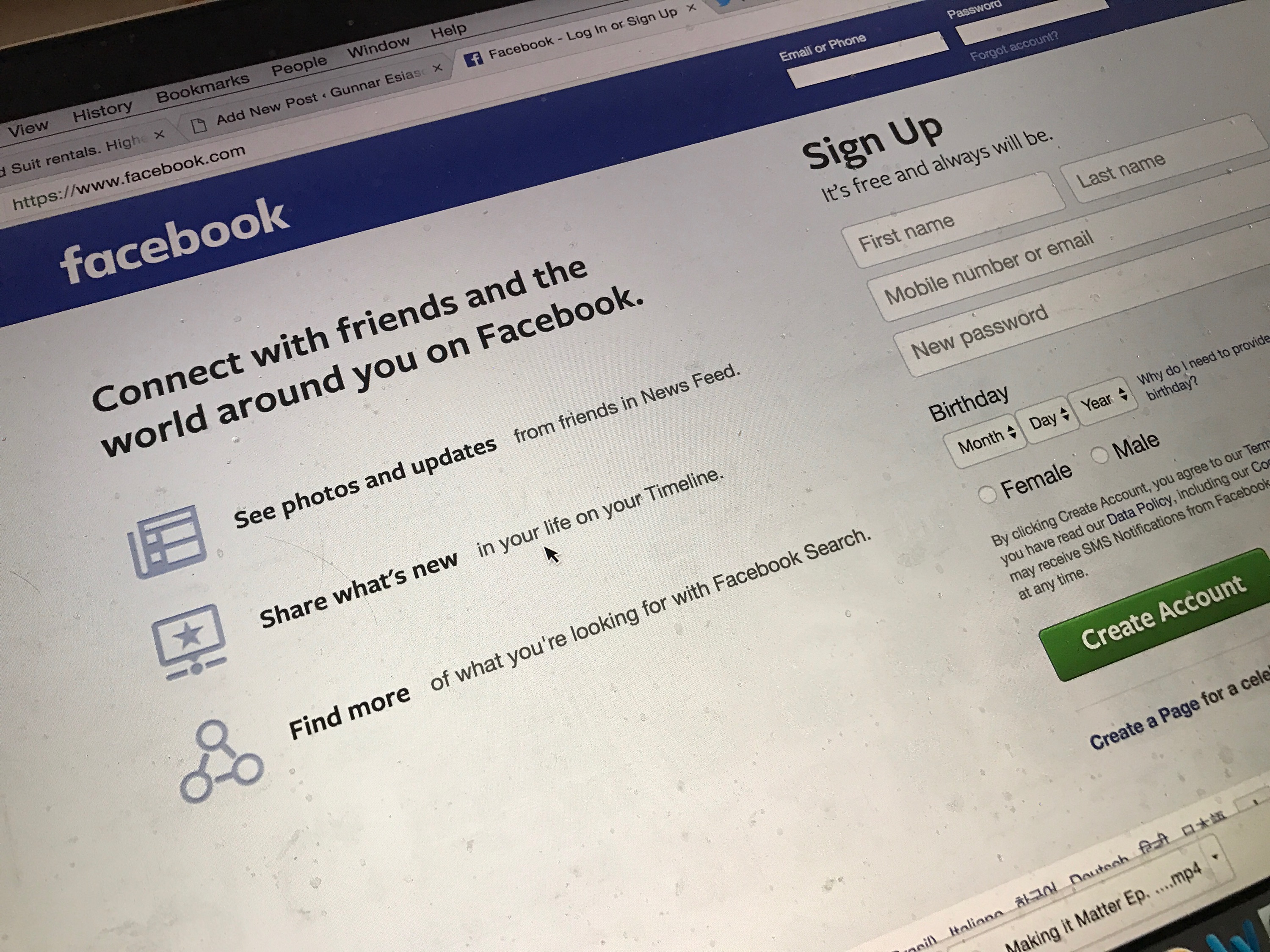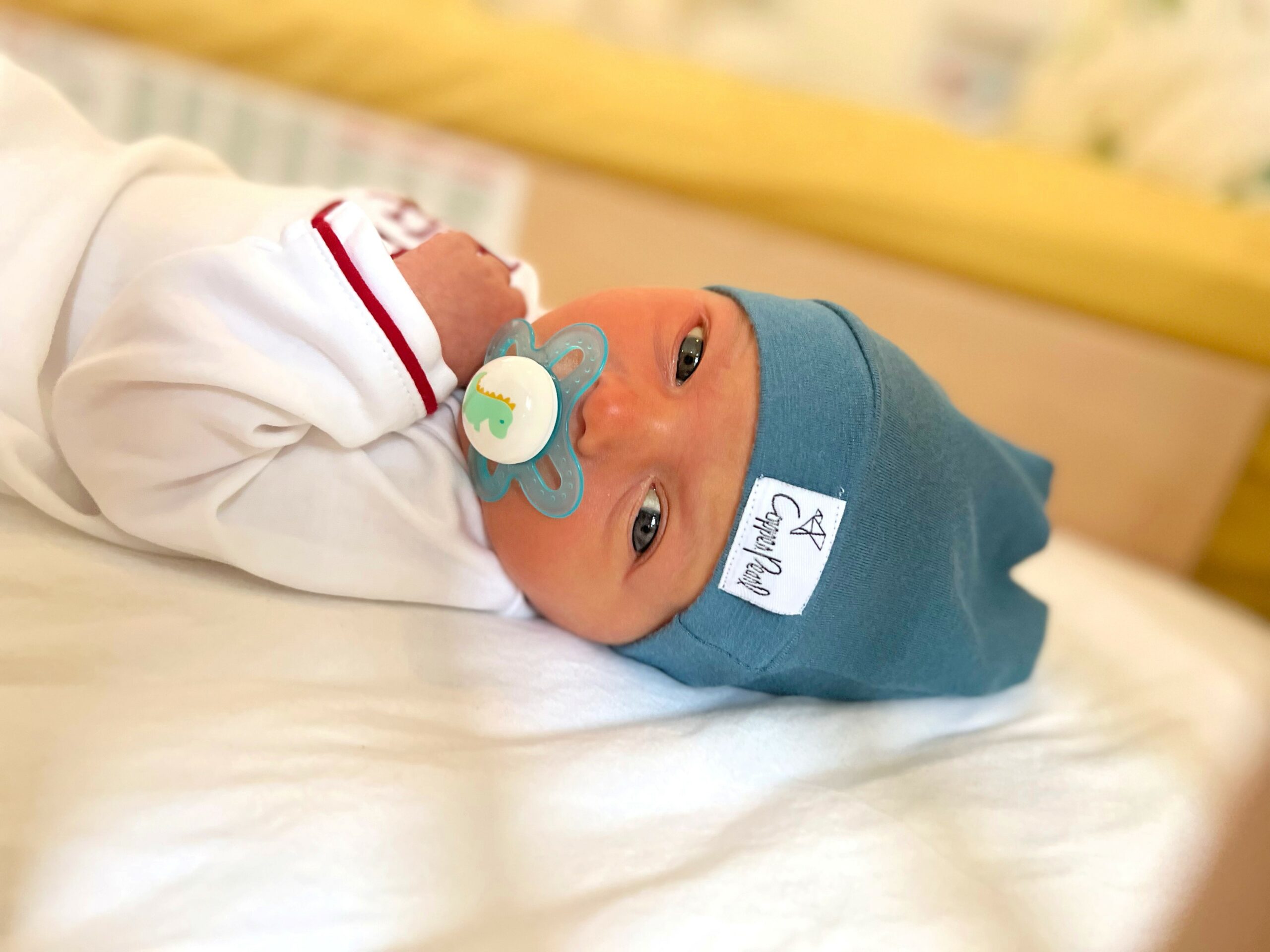I did something pretty stupid last week, which almost led to a catastrophe.
One of my best friends is getting married in a couple of weeks, so we went down to Austin last week for his bachelor party. In a lot of ways, it seems like a large part of my life has been spent in airports over the past couple weeks, but that’s neither here nor there.
I need to back up a bit to paint a good picture of what actually happened, though. About a month and a half ago I tore my plantar plate, which is basically the ligament that connects my toes to the rest of my foot. It’s been an annoying injury that will not go away. As a result I’ve had to wear this big ass boot to keep that shit stabilized (see attached picture).
Since the injury I’ve had to make three separate trips, counting the most recent one to Austin. I’m not in a position to brag, but I’ve subsequently become a bit of an expert in being pushed through the airport in a wheelchair. The difference between this trip to Austin, though, and the others was the length. When I travel on business, it’s usually for a single night, so I can get away with packing fewer meds and substituting the Vest with some other form of airway clearance device.
This trip to Austin was 4 days, 3 nights, which totaled 6 different treatment sessions. The bottom line is that I’ve come to rely on the Vest for airway clearance because of my naturally productive cough (meaning I bring up a ton of mucus when the Vest shakes me). So while I have not needed to wheel the Vest through the airport on my bad foot for the past couple trips, I had to figure out a way to make it happen this time around for the journey to Texas.
Altogether, here’s a quick overview of what I needed to bring with me to Austin to maintain CF care:
- Travel nebulizer
- 21 disposable travel neb-cups (3 neb-cups per treatment session, plus 3 extra incase of an issue)
- 6 regular neb-cups (sometimes I find that the travel neb cup has a hard time nebulizing larger doses of medication, so I bring the normal neb cup to nebulize my antibiotic, which typically is just a larger liquid dose. I use 1 per treatment session)
- 2 disposable nebulizer hoses (the hose delivers the air from the nebulizer to the Neb-cup)
- 4 feeding tube extenders
- 4 feeding tube syringes
- 8 cans of feeding tube formula (1 can = 11 fl. oz./500cal. [ I count this as a medication because it’s specialized prescribed formula made for tube feedings])
- Vest machine (capitalized V)
- The physical vest that is worn during the treatment (lowercase v)
- Vest hoses (the hoses inflate the Vest with air and then shake me)
- Refrigerated nebulized medicine (6 vials = 1 per treatment session) plus ice pack
- Non-refrigerated nebulized medicine (15 vials = 2 per treatment session, 3 extra as needed)
- 6 vials of powdered medication
- 6 vials of sterile water
- 10 syringes (used to reconstitute powdered medication)
- 30 alcohol pads
- Assortment of oral medication bottles (~ 300 pills = daily antibiotics + extra incase of emergency, vitamins, supplements, enzymes)
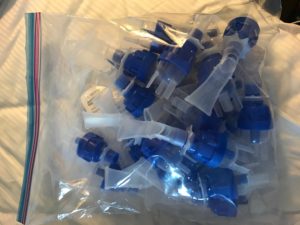
This is what the disposable travel neb-cups look like. I had two zip-lock bags with me on the trip to Austin, plus the normal sized neb-cups
It certainly isn’t a small list. It also varies based on the length of trip, for example an overnight trip is a fraction of all that – I don’t bring any feeding tube stuff with me, and like I said I’ll use something other (read: smaller) than the Vest for airway clearance since it’s an unnecessary hassle for a 24-hour outing.
The tough part is packing all that to GO on a trip, whereas coming back is a lot easier since most of this stuff is consumable, or used up by the time I’m ready to come home. I only bring back the physical machines and feeding tube gear, non-disposable neb-cups and whatever medicine I don’t use (emergency meds or any extras that weren’t needed) – aside from the machines, it can all fit into a zip-lock bag or two.
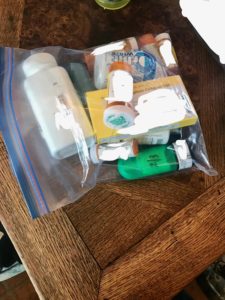
Some of the oral meds/inhalers and other miscellaneous things I’ll travel with – I had 3 of these zip-lock bags aside from the neb-cups this time around because I needed to have what it takes to reconstitute medication
To alleviate this problem, though, people with disabilities are afforded the right to carry-on as many bags of medicine and equipment as we need as long as we can prove our disability. A simple doctor’s note usually does the trick, which also helps at the security checkpoint because without a doubt something in this mix of stuff will set off the alarm. As far as I am concerned, though, it really doesn’t bother me because the TSA has a job to do, and that is to keep us safe on airplanes and in airports. If they are stopping me, they are doing their job because a lot of this stuff looks pretty funky.
As you can imagine, lugging this shit through the airport is not the most fun thing in the world, nor is physically storing it on the airplane since the bags are packed to the limit as far as carry-ons go.
Add my booted foot on top of all this, and well you’ve got the makings for a perfect storm.
Foreseeing the problem of physically moving through the airport with more than two carry-ons in New York (actually New Jersey since I flew out of Newark), onto the plane, off the plane and finally out of the airport in Austin, I decided that I would take the calculated risk of putting some of the medical stuff into a checked bag (along with my clothes). I say calculated risk because we all know the anxiety that comes with checking a bag.
Since the feeding tube formula cans are already over the TSA allowed liquid limit on an airplane, they went into the checked bag. That was one less thing to explain at the checkpoint, and eight cans together can be pretty heavy also. The last two things that went into my checked bag were the physical vest that I wear (not the machine) and the Vest hoses. That decision was made based on size and priority. I could not fit them in my already crowded carry-ons, which included the Vest Machine and everything else listed above. I also have a vest (part that I wear) and Vest hoses from an older model machine that will work with my newer upgrade if they were to be lost. The downside is that I would have had to wait until I got back to New York to resume proper airway clearance.
The Vest machine itself is simply too expensive to check, and it’s not something that can be easily replaced if it were to be lost or stolen. Aside from the aerosolized medications, which serve as critical care, the Vest machine is the highest priority for a carry on.
Here’s a picture of everything that comes together to serve as the Vest airway clearance device for reference.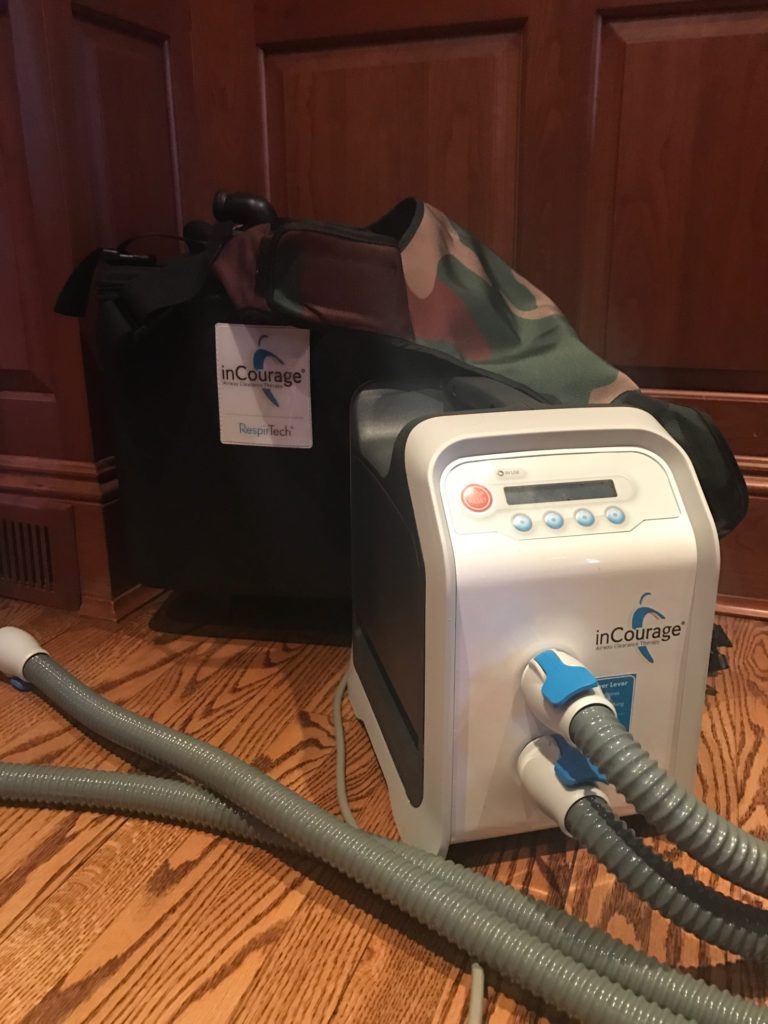
Now, just to throw a little salt in the wound that was about to be opened, my mom even said something to me about risking the vest and hoses in a checked bag. She offered to help repack my carry-on bag to make everything fit. I dismissed her concern as any son who is about to be proven wrong usually does.
Fast forward a couple hours later…..I land in Austin only to get a text message notification (pretty convenient actually) from United that my checked bag didn’t make it.
Aside from the laughably funny part that United Airlines keeps taking L’s, I suddenly realized that not only had my mom been right, but also I would not be able to do my treatments effectively. I’m not sure which was worse, having to face my mom on a phone call and tell her that I was wrong and she right, or that I ‘d maybe be suffering some health consequences.
Fortunately for me (and United), the lady at the baggage claim desk was extremely helpful and was definitely concerned with getting my bag to me in a timely manner. Admittedly I was a bit aggravated, and probably not the friendliest customer since I was in there demanding a refund or some sort of compensation, but she promised that she’d do everything she could to get the bag down to my hotel, which later included haggling with a courier service.
In all fairness being a baggage claim representative for an airline is a thankless job. It takes a saint of a person to be able to deal with angry passengers all day. Beyond that airline travel is a major logistical nightmare. Air travel employees perform God’s work in keeping airports open and running them as smoothly as possible. That is definitely not lost on me.
And wouldn’t you know it, the bag with my medications and equipment arrived to my hotel about 5 or 6 hours after I did. The conundrum definitely disrupted my treatment routine and made me sweat a bit, but I was able to recover.
I think ultimately the lesson here is that unfortunately it is impossible to totally rely on other people for care. I don’t say that lightly. I entrusted the airline and Newark Liberty Airport to make sure everything was handled smoothly, but it was not and I nearly put my health in jeopardy because of a decision that I made. This is a single example in the life of someone with cystic fibrosis where constant care is required. Ultimately I am the patient and the actions of not only my self but also those around me can make a significant positive or negative impact on my life. Had I listened to my mom and repacked my carry-on bag, this could have been avoided. Losing a bag of clothes and feeding tube formula isn’t quite as damming as losing some Vest equipment. It would have been able improvise had I only lost the medical formula. It would have taken some creativity but it would have been an easier challenge to overcome. Conversely I put my fate in the number of people that it takes to get a checked bag halfway across the country. Those people succeed 99 out of 100 times, which in just about every line of work is considered success. Still it is not acceptable for a person with cystic fibrosis to go without care for an extended period of time, and I can’t blame the baggage workers for my fault in making a careless packing decision. Ultimately the blame has to fall on me in this moment for entrusting part of my care in a machine that has too many variables.
Here’s my roller coaster of emotions as expressed on Twitter:
Hey @united great job getting me to Austin safely, too bad you left my bag of MEDICATION and MEDICAL EQUIPMENT back at Newark Liberty ??????
— Gunnar Esiason (@G17Esiason) May 4, 2017
Update: 4 hours later, the bag has arrived. Resume breathing
— Gunnar Esiason (@G17Esiason) May 5, 2017
Update: all bags made it to Newark Liberty from Austin on the same plane as me!!!!!
— Gunnar Esiason (@G17Esiason) May 7, 2017

